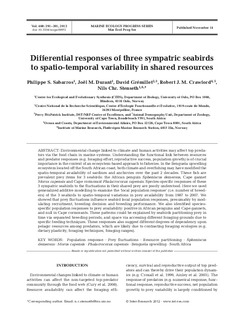| dc.description.abstract | Environmental change linked to climate and human activities may affect top predators
via the food chain in marine systems. Understanding the functional link between resources
and predator responses (e.g. foraging effort, reproductive success, population growth) is of crucial
importance in the context of an ecosystem-based approach to fisheries. In the Benguela upwelling
ecosystem located off the South African coast, both climate and overfishing may have modified the
spatio-temporal availability of sardines and anchovies over the past 2 decades. These fish are
prevalent prey items for 3 seabirds: the African penguin Spheniscus demersus, Cape gannet
Morus capensis and Cape cormorant Phalacrocorax capensis. Species-specific responses of these
3 sympatric seabirds to the fluctuations in their shared prey are poorly understood. Here we used
generalized additive modelling to examine the ‘local population response’ (i.e. number of breeders)
of the 3 seabirds to spatio-temporal variations in prey availability from 1987 to 2007. We
showed that prey fluctuations influence seabird local population responses, presumably by modulating
recruitment, breeding decision and breeding performance. We also identified speciesspecific
population responses to prey availability: positive in African penguins and Cape gannets,
and null in Cape cormorants. These patterns could be explained by seabirds partitioning prey in
time via separated breeding periods, and space via accessing different foraging grounds due to
specific feeding techniques. These responses also suggest different degrees of dependency upon
pelagic resources among predators, which are likely due to contrasting foraging ecologies (e.g.
dietary plasticity, foraging techniques, foraging ranges). | no_NO |
